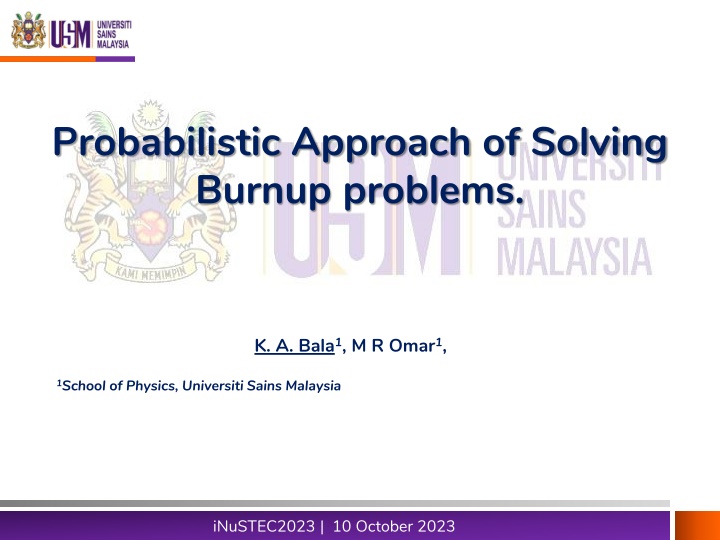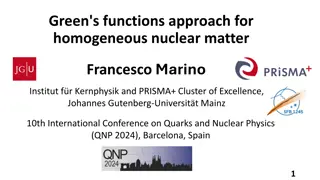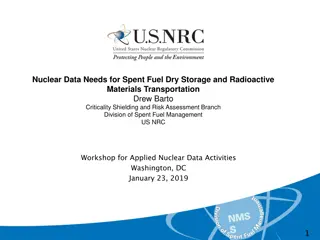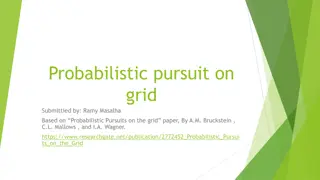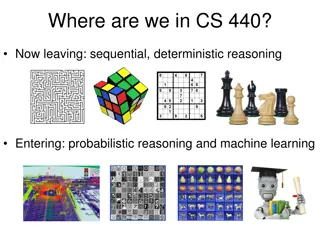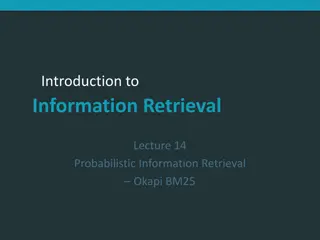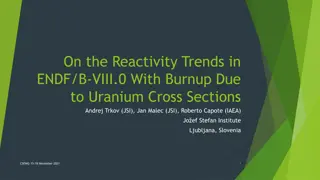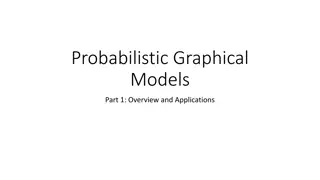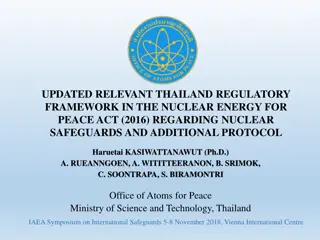Probabilistic Approach for Solving Burnup Problems in Nuclear Transmutations
This study presents a probabilistic approach for solving burnup problems in nuclear transmutations, offering a new method free from the challenges of traditional approaches. It includes an introduction to burnup equations, outlines of the methodology, and the probabilistic method's mathematical formulation. The advantages of this new method, which avoids the complexities of matrix exponentials, are highlighted through sample calculations and theoretical background.
Download Presentation

Please find below an Image/Link to download the presentation.
The content on the website is provided AS IS for your information and personal use only. It may not be sold, licensed, or shared on other websites without obtaining consent from the author.If you encounter any issues during the download, it is possible that the publisher has removed the file from their server.
You are allowed to download the files provided on this website for personal or commercial use, subject to the condition that they are used lawfully. All files are the property of their respective owners.
The content on the website is provided AS IS for your information and personal use only. It may not be sold, licensed, or shared on other websites without obtaining consent from the author.
E N D
Presentation Transcript
Probabilistic Approach of Solving Burnup problems. K. A. Bala1, M R Omar1, 1School of Physics, Universiti Sains Malaysia iNuSTEC2023 | 10 October 2023
Outlines We l e a d i. Bateman equations Probabilistic Method Approximation order Sample Calculations Theoretical Background Introduction i. Sample 1 ii. Sample 2 iii. Sample 3 5. Conclusions 2
Introduction We l e a d Nuclear Transmutations By Decay By fission and fusion, etc. 3
Introduction (cont.) We l e a d Burnup equation ?? ??= ?.? (1) Or in a compact matrix form ?? = ???.?? (2) where, ?? Is the future concentrations of nuclides involved in the calculation at a particular time, And ?? Is the initial concentrations of nuclides at t=0sec while ??? Is the matrix exponential. 4
Introduction (cont.) We l e a d Challenges Determining a simple and reliable algorithm of solving stiff burnup problems Finding the matrix exponential in Eq. (2) is not easy Traditional Method Chebyshev rational approximation method (CRAM) Taylor series, etc Both use matrix exponential New method Probabilistic method Advantage of new method: free from matrix exponential 5
Probabilistic Method We l e a d Generally, the concentration of nuclides i at a given time ? + ?, is contributed by two factors. Firstly, it is contributed by the un-reacted nuclides i within the interval (?,? + ?). Secondly, it is contributed by the transmutation of other nuclides that occur within the interval (?,? + ?), which leads to the production of nuclide i. Therefore, the concentration of nuclide i after the next sub-step, ? + ? , can be expressed as, . 6
Probabilistic Method (cont.) We l e a d ??(? + ?) = ?? ???(?) + ?? ???? (?) ? ? where?? ? ??,? is the probability of nuclide i not undergoing a transmutation event; ?? ? Is the probability of any nuclides l undergoing a transmutation event that transforms themselves into nuclide i . By definition, ?? ?= ?? (?) ? ? 7
Probabilistic Method (cont.) We l e a d Repository of the C++ code that implements the Probabilistic Approach: https://github.com/rabieomar92/cnuctran, we give comprehensive information on the new methodology 8
Sample Calculations We l e a d Simulation was done by CNUCTRAN and compared the results against Chebyshev Rational Approximation Method of order 48 (CRAM48). The nuclides data, such as the half-lives and other transmutation chains of over 4000 nuclides, are fetched from an XML file provided by ENDF, Table 1 provide the summary of the sample calculations. 9
Table 1: Sample Calculations We l e a d Total Nuclides Nuclides Involved Initial Reaction rates Time Step (sec) Sample Concentratio ns (mol) 1489 (150,250) U-235, U- 2380 U-235: 0.1, U-238: 0.9 (n, a:1E-4, n, gamma:1E- 4, fission:1E-5) 1 8.64E4 1603 (150,264) U-235, U- 238 U-235: 0.1, U-238: 0.9 (n, a:1E-4, n, gamma:1E- 4, fission:1E-5) 2 8.64E6 1632 (137,237) 3 Np-237 Np-237: 1.0 Pure Decay 1E13 10
Sample 1 We l e a d Figure 1: Relative error versus sample 1 after ?.?? ?????? The results obtained show 224 nuclides with non-zero concentration. 16 nuclides with negative CRAM concentration, and these nuclides have a zero concentration on CNUCTRAN. 1249 nuclides with both zero CRAM and CNUCTRAN concentration. 11
fig 1 of Sample 1 (cont.) We l e a d 12
Sample 2 We l e a d Figure 2: Relative error versus sample II after ?.?? ??????. the results obtained show 224 nuclides with non-zero concentration. 25 nuclides with negative CRAM concentration, and these nuclides have zero concentration on CNUCTRAN. 1354 nuclides with zero concentration on both two methods. 13
Fig 2 of sample 2 (cont.) We l e a d 14
Sample 3 We l e a d Figure 3: Relative error versus sample III after ? ??????? The results obtained show 15 nuclides with non-zero concentration. 1617 nuclides with both zero CRAM and CNUCTRAN concentration. 15
Fig 3 of sample 3 (Cont.) We l e a d 16
Table 2: CPU Time Comparison We l e a d CPU Time (CNUCTRAN @2.20GHz,2co res) 1.274 CPU Time (CRAM, @2.20GHz,2cores) Time step, t 0.781 8.64 104??? 1.294 0.828 8.64 106??? 1 1013??? 1.200 0.672 17
Conclusions We l e a d Previously, the probability distribution of transmutation events is used. This work used CNUCTRAN . The numerical results for various burnup problems demonstrate the accuracy and efficiency of the probabilistic method, making it a promising alternative for simulating realistic nuclear transmutations. 18
References We l e a d [1] bateman 1910 . [2] approximation method , Ann Nucl Energy, vol. 150, Jan. 2021, doi: 10.1016/j.anucene.2020.107828. O. Calvin, S. Schunert, and B. Ganapol, Global error analysis of the Chebyshev rational [3] systems , Energies (Basel), vol. 14, no. 6, 2021, doi: 10.3390/en14061520. J. Cetnar, P. Stanisz, and M. Oettingen, Linear chain method for numerical modelling of burnup [4] Ann Nucl Energy, vol. 38, no. 2 3, pp. 261 268, Feb. 2011, doi: 10.1016/j.anucene.2010.10.019. A. E. Isotalo and P. A. Aarnio, Comparison of depletion algorithms for large systems of nuclides , [5] application for solving burnup problems , Progress in Nuclear Energy, vol. 152, Oct. 2022, doi: 10.1016/j.pnucene.2022.104395. M. R. Omar and J. A. Karim, The probability distribution of transmutation events and its [6] Nuclear Engineering and Technology, vol. 51, no. 4, pp. 949 953, Jul. 2019, doi: 10.1016/j.net.2019.01.006. Y. Cai, X. Peng, Q. Li, L. Du, and L. Yang, Solving point burnup equations by Magnus method , [7] ISOBURN, a new depletion code , Ann Nucl Energy, vol. 159, p. 108319, 2021, doi: 10.1016/j.anucene.2021.108319. E. Tavakkoli, M. Zangian, A. Minuchehr, and A. Zolfaghari, Development and validation of [8] D. M. Gordon, A Survey of Fast Exponentiation Methods , 1998. [9] Transposition , ACM Transactions on Mathematical Software (TOMS), vol. 4, no. 3, pp. 250 269, 1978, doi: 10.1145/355791.355796. F. G. Gustavson, Two Fast Algorithms for Sparse Matrices: Multiplication and Permuted 19
Acknowledgements We l e a d The authors wish to express their gratitude to Universiti Sains Malaysia for financing this research The Fundamental Research Grant scheme, no. FRGS/1/2022/STG07/USM/02/09. 20
We l e a d Thank You 21
